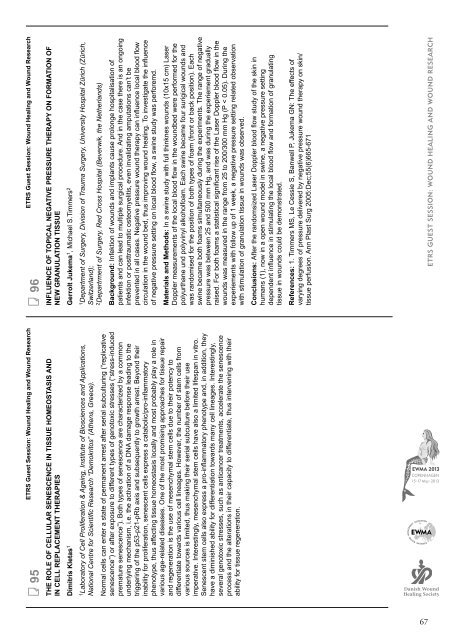Create successful ePaper yourself
Turn your PDF publications into a flip-book with our unique Google optimized e-Paper software.
ETRS GUEST SESSION: WOUND HEALING AND WOUND RESEARCH<br />
ETRS Guest Session: Wound Healing and Wound Research<br />
95<br />
The role of cellular senescence in tissue homeostasis and<br />
in cell replacement therapies<br />
Dimitris Kletas 1<br />
1 Laboratory of Cell Proliferation & Ageing, Institute of Biosciences and Applications,<br />
National Centre for Scientific Research “Demokritos” (Athens, Greece).<br />
96<br />
ETRS Guest Session: Wound Healing and Wound Research<br />
Influence of topical negative pressure therapy on formation of<br />
new granulation tissue<br />
Gerrolt Jukema 1 , Michael S.Timmers 2<br />
1 Department of Surgery, Division of Trauma Surgery, University Hospital Zürich (Zürich,<br />
Switzerland);<br />
2 Departrment of Surgery, Red Cross Hospital (Beverwik, the Netherlands)<br />
Background: Infektion of wounds and implants cause prolonge hospitalisation of<br />
patients and can lead to multiple surgical procedure. And in the case there is an ongoing<br />
infektion or posttraumatic osteomyelitis, even invalidating amputations can’t be<br />
prevented in all cases. Negative pressure wound therapy can influence local blood flow<br />
circulation in the wound bed, thus improving wound healing. To investigate the influence<br />
of negative pressure setting on local blood flow, a swine study was perforemd.<br />
Materials and Methods: In a swine study with full thinknes wounds (10x15 cm) Laser<br />
Doppler measurements of the local blood flow in the woundbed were performed for the<br />
polyurthane und polyvinyl alkoholfoam. Each swine became four surigical wounds and<br />
was randomised for the position of both types of foam (front or back position). Each<br />
swine became both foams simultaneously during the experiments. The range of negative<br />
pressure was between 25 and 500 mm Hg, and was during the experiement gradually<br />
raised. For both foams a statistical significant rise of the Laser Doppler blood flow in the<br />
wounds was measured in the range from 25 to 200/300 mm Hg (P < 0.05). During the<br />
experiements with follow up of 1 week, a negative pressure setting related observation<br />
with stimulation of granulation tissue in wounds was observed.<br />
Conclusions: After the randomsized Laser Doppler blood flow study of the skin in<br />
humans (1), now in a open wound model in swine, a negative pressure setting<br />
dependent influence in stimulating the local blood flow and formation of granulating<br />
tissue in wounds could be demonstrated.<br />
References: 1. Timmers MS, Le Cessie S, Banwell P, Jukema GN: The effects of<br />
varying degrees of pressure delivered by negative pressure wound therapy on skin/<br />
tissue perfusion. Ann Plast Surg 2005:Dec;55(6)665-671<br />
Normal cells can enter a state of permanent arrest after serial subculturing (“replicative<br />
senescence”) or after exposure to different types of genotoxic stresses (“stress-induced<br />
premature senescence”). Both types of senescence are characterized by a common<br />
underlying mechanism, i.e. the activation of a DNA damage response leading to the<br />
triggering of the p53-p21-pRb axis and subsequently to growth arrest. Beyond their<br />
inability for proliferation, senescent cells express a catabolic/pro-inflammatory<br />
phenotype, thus affecting tissue homeostasis locally and most probably play a role in<br />
various age-related diseases. One of the most promising approaches for tissue repair<br />
and regeneration is the use of mesenchymal stem cells due to their potency to<br />
differentiate towards various cell lineages. However, the number of stem cells from<br />
various sources is limited, thus making their serial subculture before their use<br />
imperative. Interestingly, mesenchymal stem cells have also a limited lifespan in vitro.<br />
Senescent stem cells also express a pro-inflammatory phenotype and, in addition, they<br />
have a diminished ability for differentiation towards many cell lineages. Interestingly,<br />
several genotoxic stresses, such as anticancer treatments, accelerate the senescence<br />
process and the alterations in their capacity to differentiate, thus intervening with their<br />
ability for tissue regeneration.<br />
<strong>EWMA</strong> <strong>2013</strong><br />
COPENHAGEN<br />
15-17 May · <strong>2013</strong><br />
Danish Wound<br />
Healing Society<br />
67






